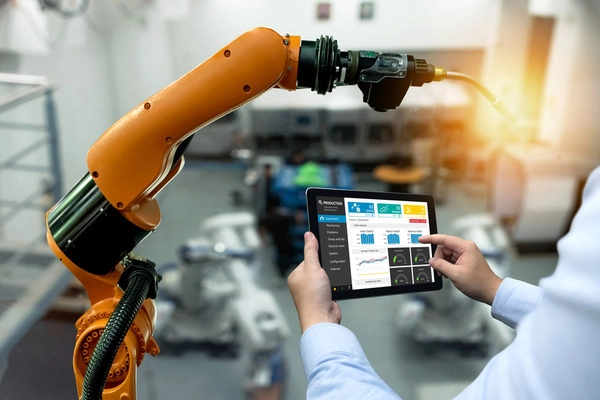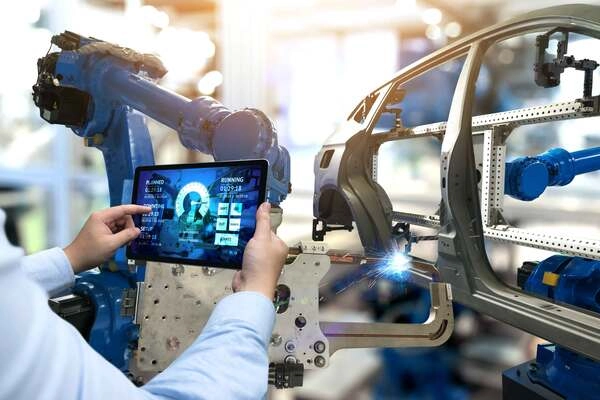In the context of Industry 4.0, equipment maintenance is no longer just about fixing machines when they fail; it is gradually transforming into a smarter, more predictive, and optimized process. IoT in equipment maintenance has become a key solution that helps businesses enhance operational efficiency, reduce costs, and improve safety. This article will explore in detail the concept, roles, application models, benefits, real-world implementations, challenges, and future trends of IoT in equipment maintenance.
What is IoT in equipment maintenance?
IoT (Internet of Things) refers to a network of internet-connected devices that collect and share real-time data. When applied to maintenance, IoT enables continuous monitoring of machine conditions, early detection of potential issues, and more accurate maintenance planning.

IoT devices can include temperature, vibration, pressure, and humidity sensors, along with various other technical measurement tools. The data collected from these sensors is analyzed using specialized software, enabling businesses to detect abnormal signs before equipment encounters serious failures. As a result, IoT in equipment maintenance not only extends the lifespan of machinery but also minimizes downtime.
The role of IoT in smart equipment maintenance
IoT plays a crucial role in transforming traditional maintenance methods into intelligent maintenance strategies. Instead of relying on fixed schedules or repairing equipment only after a breakdown, IoT enables businesses to:
- Monitor equipment condition continuously, 24/7.
- Analyze large-scale data (Big Data) to predict potential failures.
- Optimize maintenance schedules, reducing labor and material costs.
By applying IoT, businesses can shift from reactive maintenance to predictive and proactive maintenance, improving operational efficiency and reducing technical risks.
IoT-based maintenance models
To implement maintenance effectively, organizations can adopt several IoT-powered smart maintenance models:

Predictive Maintenance
Predictive maintenance uses data collected from IoT sensors to forecast the likelihood of equipment failure. With the support of data analytics and artificial intelligence (AI), the system can provide early warnings of potential issues.
For example, vibration sensors on a motor can detect abnormalities before the motor experiences a malfunction, allowing maintenance teams to plan timely interventions.
Proactive Maintenance
Proactive maintenance focuses on identifying and eliminating the root causes of failures before they occur. IoT provides continuous data on equipment conditions, enabling technical teams to analyze and implement preventive measures.
This approach not only minimizes risks but also extends the lifespan of equipment and reduces operational costs.
Condition-Based Maintenance
Condition-based maintenance relies on specific thresholds or operating conditions. When sensor readings exceed permitted levels, the system triggers alerts or automatically initiates maintenance actions.
For instance, an air compressor may require inspection or filter replacement when pressure or temperature surpasses safe limits, instead of following a fixed maintenance schedule.
Benefits of applying IoT in equipment maintenance
Implementing IoT in equipment maintenance brings numerous practical benefits for businesses:
- Reduced downtime: Early detection of technical issues prevents unexpected breakdowns.
- Lower maintenance costs: Maintenance is performed only when needed, minimizing waste of materials and labor.
- Extended equipment lifespan: Predictive and proactive maintenance helps avoid major failures.
- Optimized operational performance: Machines operate more stably with fewer errors.
- Improved workplace safety: Reduced risk of accidents caused by malfunctioning or unstable equipment.
Real-world applications of IoT in equipment maintenance
Many companies have adopted IoT for equipment maintenance and achieved positive outcomes:

- In the manufacturing sector, sensors installed on production lines monitor temperature, vibration, and pressure to predict potential equipment failures.
- In the energy sector, turbines, generators, and distribution systems are continuously monitored to ensure timely maintenance.
- In logistics and transportation, IoT sensors on vehicles track engine status, tire conditions, and battery levels to reduce the risk of breakdowns during operation.
- In healthcare, critical medical equipment is monitored to ensure uninterrupted operation and patient safety.
Thanks to the data collected from IoT systems, businesses can generate detailed reports, optimize maintenance schedules, and improve overall operational performance.
Challenges and considerations when implementing IoT in equipment maintenance
Despite its advantages, implementing IoT in equipment maintenance still presents several challenges:
- High initial investment costs: Including sensors, connectivity devices, and data analysis software.
- Managing large volumes of data: IoT systems generate massive amounts of data that require efficient storage and analytic capabilities.
- Security and privacy concerns: IoT devices can become targets for cyberattacks if not properly protected.
- Employee training: Technical teams must understand IoT systems, data handling, and analytics to maximize the technology’s benefits.
To ensure successful implementation, businesses need detailed planning, appropriate solution selection, and proper integration with existing maintenance processes.
The future of IoT in equipment maintenance
The future of IoT in equipment maintenance promises significant advancements driven by the development of AI, machine learning, and cloud technologies. Notable trends include:

- Fully automated maintenance: Machines will be able to detect failures on their own and carry out repair or adjustment actions automatically.
- Multi-source data integration: IoT data will be combined with ERP, MES, and other enterprise systems to optimize the entire operational workflow.
- Advanced predictive analytics: AI will provide more accurate predictions of complex failures and optimize maintenance costs.
- Sustainable maintenance: IoT enables more efficient use of resources, reducing energy waste and material consumption during maintenance activities.
With these advancements, IoT in equipment maintenance will continue to be an indispensable tool for improving operational efficiency and enhancing business competitiveness.
Applying IoT in equipment maintenance represents a major step forward in the digital transformation of enterprises. From real-time monitoring and predictive maintenance to cost optimization and extended equipment lifespan, IoT is reshaping how businesses operate and maintain their machinery. Despite existing challenges, the benefits are well worth the investment, and the future of IoT in maintenance promises to become even smarter and more effective.
